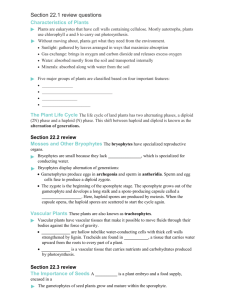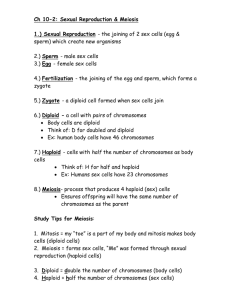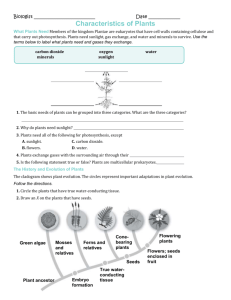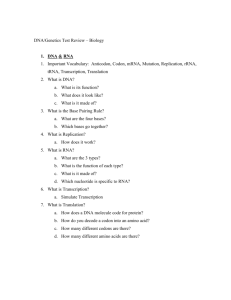Biology 3 Plants Ch 12
advertisement
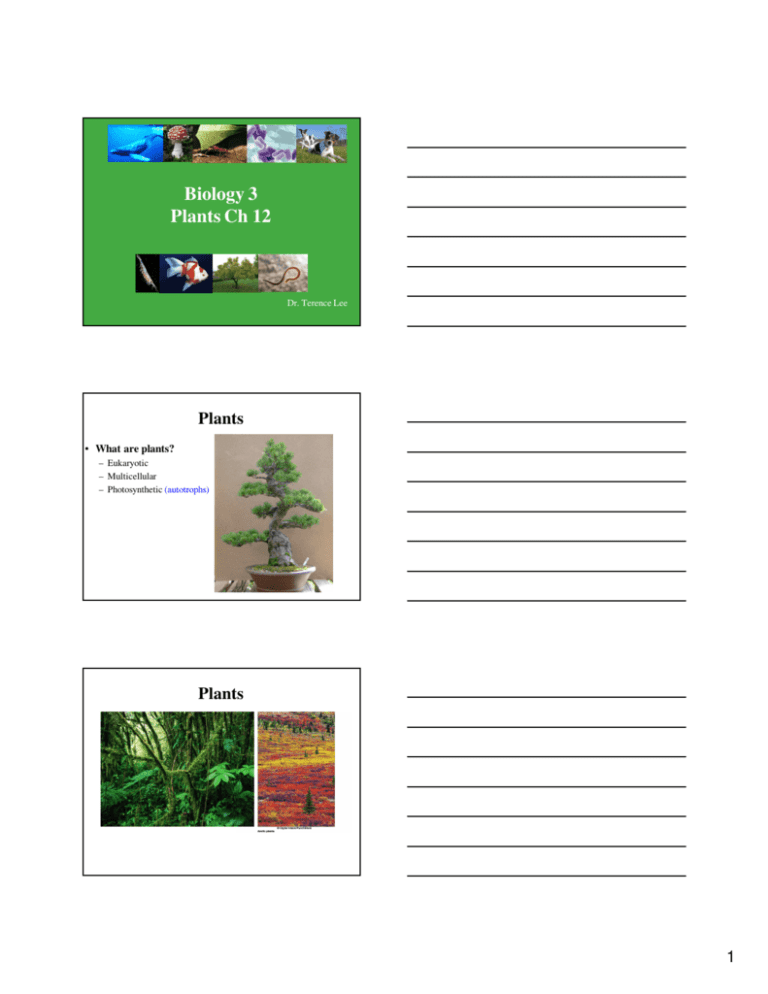
Biology 3 Plants Ch 12 Dr. Terence Lee Plants • What are plants? – Eukaryotic – Multicellular – Photosynthetic (autotrophs) Plants 1 Plants THE PLANTS Do not possess vascular tissue Non-vascular plants Possess vascular tissue Vascular seedless plants Produce seeds Gymnosperms Produce flowers and fruit Angiosperms Ancestral protist Evolution of Plants 2 Evolution of Plants • Embryo protection – External fertilization in algae – Embryo develops in tissues of plants • Vascular tissue Evolution of Plants • Seeds Evolution of Plants • Flowers – More efficient reproduction than wind dispersal 3 Evolution of Plants Summary • All of these characteristics help plants adapt to a terrestrial environment 1. 2. 3. 4. Embryo Protection Vascular Tissue Seeds Flowers Alternation of Generations • Alternation of Generations: – Key characteristic in plants – Life cycle that switches from diploid (2n) to haploid (1n) and back. Alternation of Generations 4 Four Basic Types of Plants 1. Non-Vascular Plants 2. Seedless Vascular Plants 3. Gymnosperms 4. Angiosperms moss fern Flowering plant pine tree Non-Vascular Plants • Lacks Vascular Tissue • No true roots or leaves Non-Vascular Plants Moss 5 MOSS LIFE CYCLE FERTILIZATION 1 2 Sperm Egg Embryo HAPLOID DIPLOID STAGE STAGE 3 Spores Haploid moss 4 Diploid moss MEIOSIS 1 During rainstorms, sperm swim from male reproductive structures to female reproductive structures, where they fertilize the egg. 2 A diploid embryo forms and develops into an adult diploid moss. 3 The diploid moss develops a capsule, which bursts and releases haploid spores. 4 A spore lands on moist soil and grows into an adult haploid moss. Seedless Vascular Plants • Have vascular tissue • Diploid generation is dominant stage FERN LIFE CYCLE MEIOSIS 1 2 Spores DIPLOID STAGE HAPLOID STAGE Haploid fern Diploid fern 3 4 Sperm Egg Embryo FERTILIZATION 1 2 3 4 Adult ferns release haploid spores, which are carried by the wind to a new location. A spore lands on moist soil and grows into a haploid fern called a prothallus. During rainstorms, sperm swim from male reproductive structures to female reproductive structures, where they fertilize the egg. A diploid embryo forms and continues to grow into an adult diploid fern. 6 Seed Producing Vascular Plants • Gymnosperms – “Naked Seeds” • Angiosperms – “Covered Seeds” SEEDS: STRUCTURE AND GROWTH STRUCTURE Fertilization produces a diploid seed, which contains a multicellular embryo and a store of carbohydrate (endosperm) to fuel its initial growth. GROWTH A seedling draws energy from the endosperm while it extends its leaves upward to begin photosynthesis and its roots downward into the soil to reach water and nutrients. Embryo Protective coating Endosperm Gymnosperms • Most gymnosperms are conifers (pine trees) • Diploid generation is the dominant stage Female Cones Male Cones 7 Ginkgos and Cycads GYMNOSPERM LIFE CYCLE MEIOSIS 1 2 Pollen Male cone FERTILIZATION HAPLOID STAGE Female cone Male cones release pollen grains that are dispersed by the wind to ovules found beneath the scales of female cones. 2 Pollen grains release sperm that fertilize an egg within the ovule. 3 Fertilization creates a diploid embryo that matures into a seed. 4 Eventually, the seed is released from the female cone, and grows into an adult tree. 3 DIPLOID STAGE Embryo Diploid conifer 1 Ovule Seed 4 The evolution of seeds by gymnosperms eliminates the free-living haploid life stage seen in mosses and ferns. Angiosperms • • • • Flowering plants Diploid generation is dominant Have protective seed coats Have double fertilization – Two sperm are involved in fertilization 8 Angiosperms have developed a way to transfer pollen efficiently from the anthers of one flower to the stigma of another: get an animal to carry it! COEVOLUTION: FLOWERS AND THEIR POLLINATORS COLORS AND PATTERNS WHITE: Nocturnal pollinators, such as moths and bats BRIGHT: Visually oriented, diurnal pollinators, such as birds, butterflies, and bees COEVOLUTION: FLOWERS AND THEIR POLLINATORS FLOWER STRUCTURE TUBE: Pollinators with long tongues, such as moths INTRICATE/CLOSED: Pollinators such as bees 9 Flower Structure Flower Structure • Pistil – Stigma = accepts pollen – Style = Transports pollen to ovary – Ovary = site of fertilization • Stamens – Filament – holds up anther ANGIOSPERM LIFE CYCLE MEIOSIS Pollen 1 2 HAPLOID STAGE 3 Ovary DIPLOID STAGE Ovule Diploid flower Seed 4 FERTILIZATION 1 Male anthers release haploid pollen grains that are delivered to the stigma of another flower. 2 A pollen grain produces a tube that extends through the stigma to the ovary. Within the ovule of the ovary, a spore divides into seven haploid cells. One cell becomes the egg, another cell— with two nuclei—will form the endosperm following fertilization by a sperm cell. 3 Two sperm are released by the pollen grain. In a process called double fertilization, one sperm fuses with the egg to form a zygote, while the other sperm fuses with the two nuclei of the endosperm-forming cell. 4 The zygote and the endosperm continue to develop within the ovule, forming a seed that will eventually be released and grow into a mature plant. 10 HAPLOID AND DIPLOID LIFE STAGES Haploid life stage Diploid life stage NON-VASCULAR PLANTS The majority of the life cycle is spent in the haploid stage. VASCULAR SEEDLESS PLANTS The haploid and diploid stages are both multicellular and physically independent from one another. GYMNOSPERMS The evolution of seeds in gymnosperms almost completely eliminates the prominent haploid stage seen in mosses and ferns. ANGIOSPERMS Haploid gametes are further reduced in size, enabling more rapid seed production. As plants have developed different reproductive strategies, they have progressed from having a prominent haploid stage of life to simply having haploid gametes. SEED DISPERSAL HITCHING A RIDE Seed pods have spines or projections that attach them to passing animals. SEED DISPERSAL FLYING AND FLOATING The structure of the seed allows it to be carried away from the parent plant by wind or water. 11 SEED DISPERSAL PROVIDING A FOOD SOURCE Fleshy fruit is a form of bait that lures an animal to eat the seed and carry it far from the parent plant before eliminating it. MYCORRHIZAE Mycorrhizal fungi grow in association with the roots of plants, receiving sugar from the plant and transferring nitrogen and phosphorus from the soil to the plant. ECTOMYCORRHIZAE Hyphae press closely against the outer side of the cell walls of the root hairs. Hyphae Cell wall Root hair ENDOMYCORRHIZAE Hyphae grow through cell walls into the space between the cell wall and plasma membrane of root hair cells. Hyphae Plasma membrane 12


